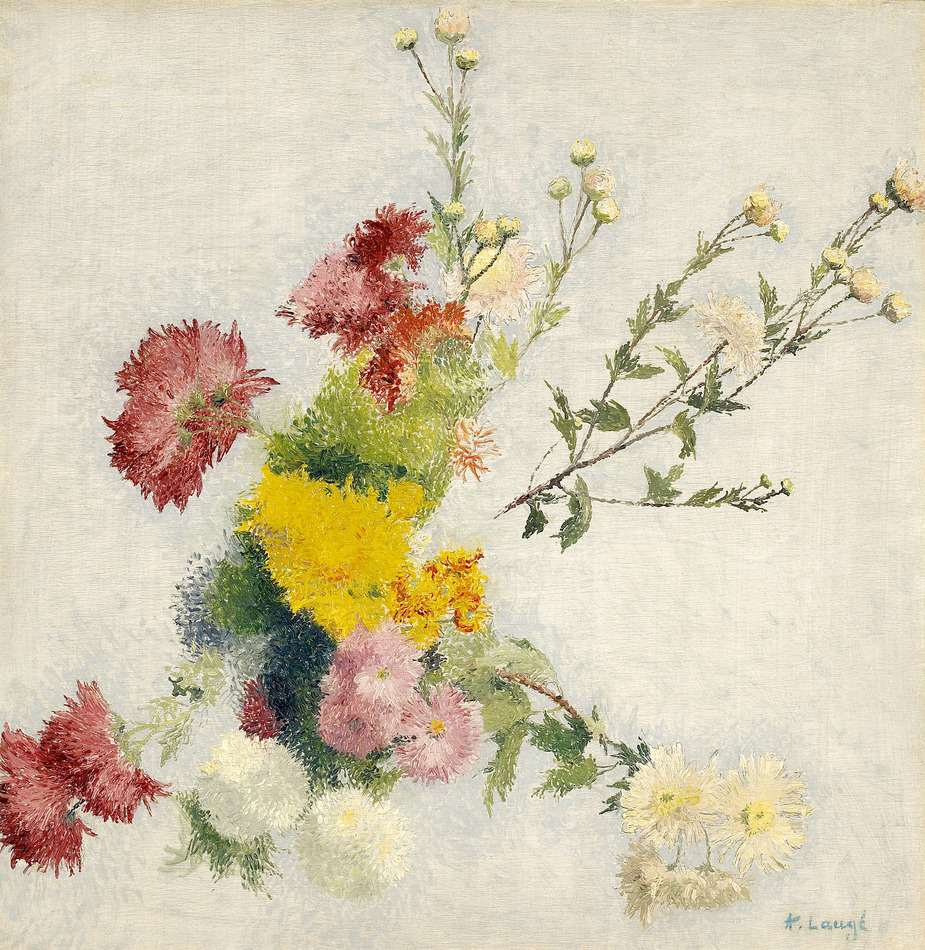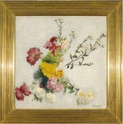Frise de Fleurs
Signed with studio stamp lower right: A. Laugé
Achille Laugé was born in Arzens in the Aude region of France, and became a follower of Neo-Impressionism. The son of well-to-do farmers who moved to Cailhau near Carcassonne, where he spent most of his life, Laugé began studies in Toulouse in 1878 and went to Paris in 1881. At the Ecole des Beaux-Arts he studied with Alexandre Cabanel and Jean-Paul Laurens. While at the École, Antoine Bourdelle, whom Laugé had known in Toulouse, introduced him to Aristide Maillol and the three maintained a long and fruitful friendship. In 1888, after seven years in Paris (including a term of military service), Laugé returned to the south and established himself at Carcassonne. Finally, in 1895, he returned to Cailhau where he spent the rest of his life.
Laugé?s time in Paris spanned the critical years from 1886 to1888 (Seurat's La Grande Jatte was first exhibited amidst much controversy in 1886) and his contact with Neo-Impressionism should not be underestimated. In 1894 he exhibited at the Salon des Indépendants, as well as at a Toulouse exhibition with de Bonnard, Maurice Denis, Sérusier, Roussel, Toulouse-Lautrec and Vuillard. In addition, he held several one-man shows in Paris from 1907-1930.
It was after his departure from Paris that Laugé developed his divisionist technique, following the lead of Seurat and the Pointillists. The technique consists in juxtaposing small strokes of primary color on the canvas in such a way that the ?optical mix,? traditionally created by mixing colors on the palette, is achieved instead by the operation of the viewer?s eye at a certain distance from the painting. Although Laugé never adopted Seurat?s scientific attitude, his interest in the primacy and division of color resulted in work with a vivid, translucent palette. From 1888 until about 1896, Laugé composed his pictures with small points of color. At the end of the century he abandoned the dots and dabs and painted his landscapes, portraits, and still lifes with thin, systematically placed strokes resembling crosshatching. After 1905 he applied his pigments more freely, with enlarged strokes and thick impasto that brought him closer to a traditional impressionist technique whilst maintaining his ability to paint the translucence of southern light.
Select Bibliography:
Pointillisme: sur les traces de Seurat. Fondation de l?Hermitage, 1998.
Daulte, François, Oscar Ghez, and Ezio Gribaudo. L?Aube du Xxe siècle: Néo-Impressionistes et autour du Néo-Impressionisme. Geneva: Petit Palais, 1968.
Tamburini, Nicole. Achille Laugé, le point la ligne, la lumière. Silvana Editorial, Milan, 2009.
Selected Museum Collections:
Musée de Carcassonne; Musée de Grenoble; Indianapolis Museum of Art, The Holliday Collection, Indiana; Limoux, Musée Petiet; Montauban, Musée Ingres; Montpellier, Musée Fabre; Morlaix; Paris, Musée National d'Art Moderne; Perpignan, Musée Hyacinthe Rigaud; Toulouse, Musée des Augustins
Exhibitions:
Achille Astre (1907), Alvin Beaumont, Paris (1911), Nunès et Fiquet, Paris (1919), Bernheim-Jeune, Paris (1923), Georges Petit, Paris (1927), Galerie de la Renaissance (1929), René Zevy (1930), Musée de Limoux (1958), Musée des Augustins, Toulouse (1961) [with Bourdelle and Maillol], Marcel Flavin (1966), Kaplan Gallery, London (1966), Hammer Galleries, New York (1967), Le Musée des Beaux-Arts de Carcassonne, Le Musée Petiet de Limoux et Le Musée de la Chartreuse de Douai, ? Achille Lauge, le point, la ligne, la lumiere (2009-2010)
Request more information
News on the artist
-
NYTimes tour of @the_barnes Foundation's now closed collection of #Impressionist, #PostImpressionist & #Fauvist art. http://t.co/vlPeQhkJuly 28, 2011 @ 2:36 PM UTC
-
The battle continues: PA Judge Hears Arguments Over Moving of the @the_Barnes: http://t.co/mSUXpx6 via @AddThis #PostImpressionist #FauveAugust 2, 2011 @ 2:21 PM UTC
-
Previously unknown Klimt painting discovered in Netherlands collection: http://t.co/gM4kOKD #PostImpressionistSeptember 8, 2011 @ 3:46 PM UTC
-
Grand jury indicts woman for attacking paintings @ngadc http://t.co/YyZ6K2O via @washingtonpost #PostImpressionistSeptember 12, 2011 @ 5:06 PM UTC
-
Hemingway liked #Cabanel #Cezanne #Manet at the Met: http://t.co/IF0ljzf2 #Academic #PostImpressionistSeptember 16, 2011 @ 3:28 PM UTC
-
Modern Masters from the Stein Collection moves to Grande Palais, then the Met in Feb! http://t.co/KK3fsxap #Impressionism #PostImpressionistOctober 5, 2011 @ 5:21 PM UTC
-
New art history controversy begins: New book questions if #VanGogh really killed himself: http://t.co/P37oJSAC #PostImpressionistOctober 14, 2011 @ 3:12 PM UTC
-
Cross and Neo-Impressionism: From Seurat to Matisse at the Marmottan, Paris: http://t.co/1N02ywav #PostImpressionist #DivisionistOctober 17, 2011 @ 3:41 PM UTC
-
National Gallery of Art to reopen 19th-century French galleries in January: http://t.co/2HcCfSuF #Academic #PostImpressionist #BarbizonOctober 20, 2011 @ 9:17 PM UTC
-
#VanGogh Museum Says "Not Enough Evidence" That Artist's Death Was Anything But Suicide -ARTINFO.com http://t.co/hQZUmflw #PostImpressionistOctober 24, 2011 @ 7:40 PM UTC
-
Vincent #VanGogh and Paul #Gauguin's Journey on view at the Palazzo Ducale in Genoa: http://t.co/JOHj62X1 via @AddThis #PostImpressionistNovember 16, 2011 @ 3:55 PM UTC
-
#Monet, #Renoir and Cézanne return @FitzMuseum_UK as famous artworks go on display: http://t.co/676HHuQx #PostImpressionist #ImpressionismJanuary 3, 2012 @ 5:20 PM UTC
-
Happy Birthday Paul Cezanne, 1839!! http://t.co/tMqzOqdc #PostImpressionistJanuary 19, 2012 @ 3:49 PM UTC
-
January 25, 2012 @ 5:57 PM UTC
-
Fondation Beyeler offers a fresh review of Pierre #Bonnard's entire career: http://t.co/P9hjN4v1 #Nabis #PostImpressionist #exhibitionsJanuary 31, 2012 @ 4:55 PM UTC
-
Would love to page through this Book #Delacroix #Boudin #Degas #Cross #Guillaumin #Marquet http://t.co/qgTKbm7j #Academic #PostImpressionistFebruary 1, 2012 @ 4:33 PM UTC
-
#Pointillist painting by van #Rysselberghe enters the Portland Art Museum's collection: http://t.co/DPvBsMpt #PostImpressionist #museumsFebruary 2, 2012 @ 4:52 PM UTC
-
Only 3 weeks left to see #Cezanne and Paris @museeluxembourg http://t.co/vRLTusTe #PostImpressionist #ExhibitionsIwishIcouldseeFebruary 6, 2012 @ 4:23 PM UTC
-
#PostImpressionist masters and their handheld cameras @PhillipsMuseum: http://t.co/VVnYuWH8 #Nabis #Vuillard #Denis #Bonnard #exhibitionsFebruary 6, 2012 @ 4:56 PM UTC
-
Over 150,000 tickets booked for #VanGogh Up Close @philamuseum: http://t.co/4sr7aF2M #museums #PostImpressionist #exhibitionsMarch 30, 2012 @ 8:29 PM UTC
-
Paradises & Landscapes in the Thyssen Coll. opens in Málaga: http://t.co/bS54sQ4n #Barbizon #PostImpressionist #Impressionism #exhibitionsApril 10, 2012 @ 3:09 PM UTC
-
#Cezanne masterpiece believed recovered by Serbian police: http://t.co/ahZBm7oA #PostImpressionistApril 12, 2012 @ 7:43 PM UTC
-
Snapshot: Painters and Photography, #Bonnard to #Vuillard @PhillipsMuseum through May 6 http://t.co/xIY3M5wE #PostImpressionist #NabisApril 27, 2012 @ 4:17 PM UTC
-
The Jewish Museum NY | Edouard #Vuillard: A Painter and His Muses 1890-1940 http://t.co/W3eD536S #PostImpressionist #Nabis #exhibitionsMay 4, 2012 @ 7:18 PM UTC
-
@the_barnes reopens in its new Philadelphia home. Read the NYTimes review & slideshow http://t.co/9DwA0ibG #Impressionism #PostImpressionistMay 21, 2012 @ 5:53 PM UTC
-
And Happy belated #birthday to André #Derain, June 10, 1880. http://t.co/vrCweCbT #PostImpressionistJune 11, 2012 @ 8:48 PM UTC
-
Here's a preview of Becoming #VanGogh at the Denver Art Museum (PHOTOS) http://t.co/qy2s3TFS @HuffPostArts #exhibitions #PostImpressionistJune 26, 2012 @ 10:31 PM UTC
-
August 6, 2012 @ 4:46 PM UTC
-
August 8, 2012 @ 8:26 PM UTC
-
Van Gogh Museum receives millionth visitor http://t.co/iBHSsf8j @vangoghmuseum #museums #PostImpressionistAugust 16, 2012 @ 3:14 PM UTC
-
Heir demands #Signac painting be saved from spitballs - The Art Newspaper http://t.co/riA2hfub #Pointillism #PostImpressionistAugust 16, 2012 @ 3:17 PM UTC
-
BBC News - #VanGogh 's Flowers In A Blue Vase damage seen in X-rays http://t.co/r5X78VDO #PostImpressionismSeptember 17, 2012 @ 3:45 PM UTC
-
September 26, 2012 @ 8:31 PM UTC
-
Watch as #VanGogh 's Self Portrait changes into a photographic #portrait - http://t.co/NI1c2ZGr #PostImpressionismJanuary 14, 2013 @ 7:53 PM UTC
-
#Sunflowers wilt: #VanGogh 's masterpiece turning brown from exposure to LED lights http://t.co/MQaFgvPk via @Independent #PostImpressionismJanuary 14, 2013 @ 11:08 PM UTC
-
The Clark Art Institute receives major gift including works by #Inness #LaTouche #Mondrian http://t.co/k0l14qgnMK #PostImpressionismApril 2, 2013 @ 8:17 PM UTC
-
#VanGogh s back home in renewed Amsterdam #museum ahead of its reopening next week http://t.co/39UafzzpTW #PostImpressionismApril 29, 2013 @ 3:11 PM UTC
-
#VanGogh Museum Reopens with Revealing Exhibition http://t.co/yZ4veQThtA via @sharethis #ExhibitionsIwishIcouldsee #PostImpressionistMay 6, 2013 @ 3:11 PM UTC
-
The Morgan presents over 100 new acquisitions with works by #Manet, #Cézanne, #Vuillard, #Redon | http://t.co/xx5rKsa9oO #PostImpressionistJune 3, 2013 @ 10:05 PM UTC
-
Happy Birthday Henri #Martin, August 5, 1860! http://t.co/YjcRy3npxC #PostImpressionismAugust 5, 2013 @ 9:12 PM UTC
-
August 8, 2013 @ 8:50 PM UTC
-
Long-lost #VanGogh Painting Found in Attic - now unveiled @VanGogMuseum http://t.co/6IGfR5uJF4 #PostImpressionism #museumsSeptember 10, 2013 @ 3:56 PM UTC
-
Happy Birthday Georges Seurat, born Dec 2, 1859! http://t.co/mm1HSRpJkN #divisionism #pointillism #PostImpressionistDecember 2, 2013 @ 4:57 PM UTC
-
#Getty Museum acquires significant early drawing by Impressionist Georges #Seurat http://t.co/rojq2UFQ6M #Divisionism #PostImpressionistFebruary 10, 2014 @ 8:07 PM UTC
-
#VanGogh Repetitions opens at the Cleveland Museum, March 2 http://t.co/jnk5TC7gTs #PostImpressionist #exhibitionsIwishIcouldseeFebruary 21, 2014 @ 10:40 PM UTC
-
Happy May Day! https://t.co/AP3HsA73pU #Lauge http://t.co/509fbEkBGwMay 1, 2014 @ 3:21 PM UTC
-
July 10, 2014 @ 3:08 PM UTC
-
Indianapolis Museum of Art publishes survey of #NeoImpressionist portraiture http://t.co/xHWqGW7lE7 #divisionist #PostImpressionistAugust 13, 2014 @ 3:01 PM UTC
-
Indianapolis Museum of Art acquires major Neo-Impressionist work by #Delavallée https://t.co/DAA4JGk9IG #PostImpressionismJuly 29, 2016 @ 3:26 PM UTC
-
Nelson-Atkins to unveil renovated Bloch Galleries of European Art in winter 2017 https://t.co/KbSDRKXuCJ #PostImpressionismJuly 29, 2016 @ 3:42 PM UTC
-
MoMA's first monographic exhibition of Francis #Picabia brings together some 200 works https://t.co/jqGfakxO8O #PostImpressionism #ModernismNovember 22, 2016 @ 9:30 PM UTC
-
A belated Happy Birthday to Francis #Picabia , Jan 22, 1878! https://t.co/XLM09QnKsc #artistbirthdays #Modernism #PostImpressionismJanuary 24, 2017 @ 3:58 PM UTC




